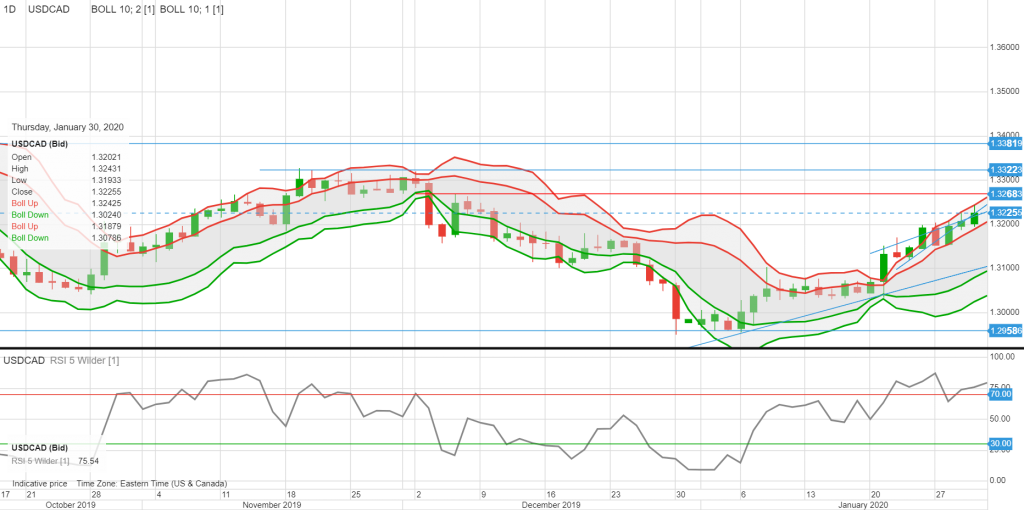
January 31, 2020
USDCAD open (6:00 am EST) 1.3238-42 Overnight Range 1.3197-1.3243
Canada’s November GDP managed to meet expectations, rising 0.1% m/m which erased the October 0.1% m/m decline. USDCAD dropped from 1.3240 to 1.3219 immediately and then retraced to 1.3235, almost as quick.
Overnight FX action was nothing to sneeze at. There were plenty of distractions and drivers moving markets, chief among them was the news that the World Health Organization (WHO). Yesterday, they declared the coronavirus a global emergency. Their press release was a textbook example for journalism students on what it means to “bury the lede.” The declaration was hidden in paragraph 15, and as statements go, it is rather “wussy.” They wrote, “The Committee agreed that the outbreak now meets the criteria for a Public Health Emergency of International Concern.” Is it a real Public Health Emergency, or does just meeting the criteria for one make it enough to cause panic?
Traders ignored Australia PPI and Chinese Manufacturing and non-manufacturing PMI data as well as a slew of Eurozone economic reports. It is month-end, and the US equity indices are poised to finish the month on a strong note, which suggests some US dollar selling against the major G-10 currencies.
The commodity currency bloc opened with losses against the US dollar but have traded higher since the New York open, in line with modest but broad US dollar selling in early trading. It is a different story for January. The US dollar rallied against the G-10 majors led by a 4.5% gain against AUD. JPY and CHF were unchanged.
Chart: Currency gain/loss (%) against the US dollar from Dec 31 NY close to Jan. 31 NY 8:45 am

Source: Saxo Bank/ IFXA Ltd
EURUSD chopped about in a narrow range as minor safe-haven demand for Euro offset selling pressure from a host of weaker-than-expected Eurozone data. German December Retail Sales were down 3.3% m/m compared to a rise of 1.6% in November. Eurozone Core CPI (actual 1.1% vs December 1.3%) and Q4 GDP (actual 1.0% y/y vs 1.2% y/y) were also disappointing. EURUSD is in an intraday uptrend, but unless resistance in the 1.1040-60 area is decisively broken, it is just a correction inside and entrenched downtrend.
The UK says “ta-ta” and “Cheerio” to its membership in the European Union today, and GBPUSD is higher. The strength in the currency has nothing to do with Brexit and everything to do with yesterday’s Bank of England monetary policy meeting. The BoE left interest rates unchanged despite Governor Mark Carney and other officials hinting about a rate cut, earlier in the month. Carney saying one thing and then doing the opposite is nothing new. Nevertheless, some GBPUSD traders were caught offside, and the currency spiked to 1.3106 from 1.2977in Asia on Thursday. Overnight, GBPUSD extended those gains, reaching 1.310 before easing down to 1.3105 in early New York trading. Month-end demand for GBPUSD is underpinning prices.
USDJPY continues to consolidate its losses after breaking support at 109.30 at the beginning of the week. The combination of coronavirus fueled safe-haven demand for yen and soft US Treasury yields are behind the move.
AUDUSD and NZDUSD have been walloped by coronavirus selling. AUDUSD dropped from 0.6810 on Monday to 0.6684 overnight. NZDUSD traded at 0.6546 on Monday and is trading in New York at 0.6460. Both currency pairs are pressured by dovish central bank monetary policies and fears of a drop in Chinese growth.
WTI oil prices dropped to $51.67/barrel yesterday but recovered by the end of the day. However, prices drifted lower overnight as traders try to assess the impact of the coronavirus on global demand for crude. Gold prices (XAUSUD) dropped from $1,585.75 yesterday to $1,570.95 after the WHO announcement was determined to be “soft”, meaning no travel bans. Prices rebounded to $1,579.80 in early New York trading today.
USDCAD rallied alongside the plunge in AUDUSD and NZDUSD. The antipodean currencies are being trashed due to their close trading relationships with China, their biggest trading partners. Canada is not in that boat. China may account for the second-largest trade volume, but it is only 4.7% of Canada’s total trade. Bank of Canada Deputy Governor Paul Beaudry’s speech yesterday appeared to be an attempt to explain why the BoC turned dovish at the last meeting when prior indications were for a neutral tone. He didn’t succeed, and his speech did not have much if any impact on trading.
USDCAD Technical Outlook
The intraday USDCAD technicals are bullish while prices are above 1.3180, looking for a break of the 1.3240-60 area to extend gains to 1.3320. However, the rally may be running out of steam in the short term. Fibonacci retracement analysis of the December-January range of 1.2955-1.3325, suggests the rally reached its price target of 76.4% retracement at 1.3235. Prices could easily retrace to 1.3170 while maintaining the longer term uptrend above 1.31054. For today, USDCAD support is at 1.3205and 1.3170. Resistance is at 1.3260 and 1.3290. Today’s Range 1.3170-1.3240
Chart: USDCAD daily

Source: Saxo Bank





